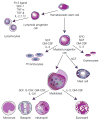Hematopoietic cytokines for cardiac repair: mobilization of bone marrow cells and beyond
- PMID: 21541807
- PMCID: PMC4281455
- DOI: 10.1007/s00395-011-0183-y
Hematopoietic cytokines for cardiac repair: mobilization of bone marrow cells and beyond
Abstract
Hematopoietic cytokines, traditionally known to influence cellular proliferation, differentiation, maturation, and lineage commitment in the bone marrow, include granulocyte colony-stimulating factor (G-CSF), granulocyte-macrophage colony-stimulating factor, stem cell factor, Flt-3 ligand, and erythropoietin among others. Emerging evidence suggests that these cytokines also exert multifarious biological effects on diverse nonhematopoietic organs and tissues. Although the precise mechanisms remain unclear, numerous studies in animal models of myocardial infarction (MI) and heart failure indicate that hematopoietic cytokines confer potent cardiovascular benefits, possibly through mobilization and subsequent homing of bone marrow-derived cells into the infarcted heart with consequent induction of myocardial repair involving multifarious mechanisms. In addition, these cytokines are also known to exert direct cytoprotective effects. However, results from small-scale clinical trials of G-CSF therapy as a single agent after acute MI have been discordant and largely disappointing. It is likely that cardiac repair following cytokine therapy depends on a number of known and unknown variables, and further experimental and clinical studies are certainly warranted to accurately determine the true therapeutic potential of such therapy. In this review, we discuss the biological features of several key hematopoietic cytokines and present the basic and clinical evidence pertaining to cardiac repair with hematopoietic cytokine therapy.
Conflict of interest statement
Figures



References
-
- Abdel-Latif A, Bolli R, Zuba-Surma EK, Tleyjeh IM, Hornung CA, Dawn B. Granulocyte colony-stimulating factor therapy for cardiac repair after acute myocardial infarction: a systematic review and meta-analysis of randomized controlled trials. Am Heart J. 2008;156:216–226. e219. doi: 10.1016/j.ahj.2008.03.024. - DOI - PMC - PubMed
-
- Achilli F, Malafronte C, Lenatti L, Gentile F, Dadone V, Gibelli G, Maggiolini S, Squadroni L, Di Leo C, Burba I, Pesce M, Mircoli L, Capogrossi MC, Di Lelio A, Camisasca P, Morabito A, Colombo G, Pompilio G. Granulocyte colony-stimulating factor attenuates left ventricular remodelling after acute anterior STEMI: results of the single-blind, randomized, placebo-controlled multicentre STem cEll Mobilization in Acute Myocardial Infarction (STEM-AMI) Trial. Eur J Heart Fail. 2010;12:1111–1121. doi: 10.1093/eurjhf/hfq150. - DOI - PubMed
Publication types
MeSH terms
Substances
Grants and funding
LinkOut - more resources
Full Text Sources
Medical
Miscellaneous

